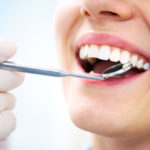Oral Piercing and Mouth Health
Should you get a lip piercing? Read this before you do.
Oral piercing of the tongue, lip, cheek, or other soft tissues is a form of body art and self-expression. Oral piercings are more typically seen in adolescents and young adults. The most common site for oral-piercing placement is the tongue.

Background
Oral piercing is an ancient practice of body modification and self-expression that is also common in modern society.
Common forms of oral jewelry include studs, barbells, rings and hoops. These can consist of a variety of metals, such as stainless steel, gold, titanium and various alloys or synthetic materials.
Complications
Numerous studies and case reports have shown that oral piercings may lead to a wide range of oral and systemic complications, including chipped teeth, gingival recession, and embedding or aspiration of jewelry (which requires surgical removal). It also potentially leads to severe infections such Ludwig’s angina or infective endocarditis.
Additionally, other complications associated with oral piercing include: swelling, bleeding, scarring, airway obstruction, hyper-salivation, palatal erythema, keloid formation, and unusual discharge from the pierced region.
Another less common form of body modification within the oral cavity is tongue splitting. By definition, the tongue-splitting process involves using various techniques to sever an individual’s tongue into two pieces. The procedure is inherently invasive and dangerous, with significant risks. This includes severe bleeding, infection, inflammation, and lingual nerve damage.
The ADA advises against the practices of cosmetic oral piercing and tongue splitting, and views these as invasive procedures with negative health sequelae that outweigh any potential benefit.
See original article on Oral Piercing/Jewelry at ADA.org
If you have questions about oral piercings, call Prima Family Dental at 781-944-4450 and make an appointment with us today.



